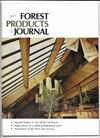近红外光谱法在线预测化学染色木材的颜色发展
IF 1.2
4区 农林科学
Q3 FORESTRY
引用次数: 2
摘要
木材的化学成分决定了在木材表面涂抹化学污渍时的颜色发展。然而,来自同一物种的不同物种和个体可能会表现出化学成分的变化,导致不同批次木材在工业染色过程中出现颜色不均匀的风险。在本研究中,开发了近红外(NIR)模型来预测应用三种不同浓度的化学染色剂醋酸铁和碳酸氢钠后木材样品的颜色发展。建模数据集包括来自五种商业木材物种的210个样本的未处理木材的近红外光谱、染色处理、浓度和染色应用前的国际照明委员会(CIE)L*a*b*色值,包括红橡树(Quercus rubra)、白橡树(Queracus alba)、黄杨(Liriodendron tulipifera)、南黄松(Pinus spp.),和西部红雪松(Thuja plicata)。这些模型是通过偏最小二乘回归(PLSR)开发的,对近红外光谱和原始光谱数据使用了13种不同的数学变换。开发并比较了具有单一斑点的模型和全局物种/斑点模型。醋酸铁的模型在预测显色方面显示出有希望的结果,交叉验证的确定系数(≥0.92),而碳酸氢钠的模型显示出可接受的结果,为0.71至0.89。然而,包括两种污渍的全局模型导致CIE L*a*b*颜色值的预测不令人满意,其为0.46至0.76。近红外模型可用于在线预测化学染色木材工业染色过程中的颜色发展。本文章由计算机程序翻译,如有差异,请以英文原文为准。
Towards Inline Prediction of Color Development for Wood Stained with Chemical Stains Using Near-Infrared Spectroscopy
The chemical composition of wood determines the color development when applying chemical stains to the surface of wood. However, different species and individuals from the same species can show variations in the chemical composition, resulting in the risk of nonuniform color development in industrial staining processes between different batches of wood. In the present study, near-infrared (NIR) models were developed to predict wood specimen color development after applying three different concentrations of the chemical stains iron acetate and sodium bicarbonate. The modeling dataset included the NIR spectra of the untreated wood, stain treatment, concentration, and the International Commission on Illumination (CIE) L*a*b* color value before stain application for 210 specimens from five commercial wood species, including red oak (Quercus rubra), white oak (Quercus alba), yellow poplar (Liriodendron tulipifera), southern yellow pine (Pinus spp.), and western red cedar (Thuja plicata). The models were developed by partial least squares regression (PLSR), using 13 different mathematical transformations on the NIR spectra as well as the raw spectral data. Models with single stains and global-species/stain models were developed and compared. The models for iron acetate showed promising results in predicting the color development with the coefficient of determination for cross-validation ( ≥ 0.92), while the models for sodium bicarbonate showed acceptable results with of 0.71 to 0.89. However, a global model including both stains resulted in an unsatisfying prediction of the CIE L*a*b* color values, with of 0.46 to 0.76. The NIR models can be useful for online predictions of color development in industrial staining processes of wood with chemical stains.
求助全文
通过发布文献求助,成功后即可免费获取论文全文。
去求助
来源期刊

Forest Products Journal
工程技术-材料科学:纸与木材
CiteScore
2.10
自引率
11.10%
发文量
30
审稿时长
6-12 weeks
期刊介绍:
Forest Products Journal (FPJ) is the source of information for industry leaders, researchers, teachers, students, and everyone interested in today''s forest products industry.
The Forest Products Journal is well respected for publishing high-quality peer-reviewed technical research findings at the applied or practical level that reflect the current state of wood science and technology. Articles suitable as Technical Notes are brief notes (generally 1,200 words or less) that describe new or improved equipment or techniques; report on findings produced as by-products of major studies; or outline progress to date on long-term projects.
 求助内容:
求助内容: 应助结果提醒方式:
应助结果提醒方式:


